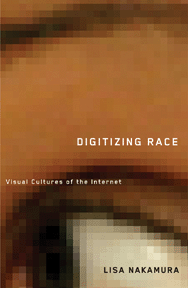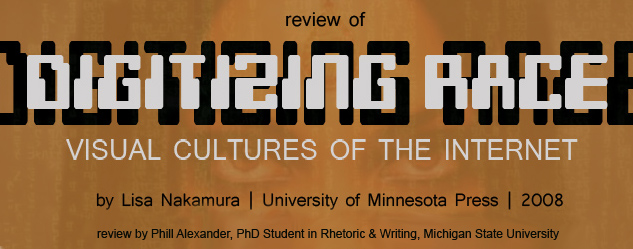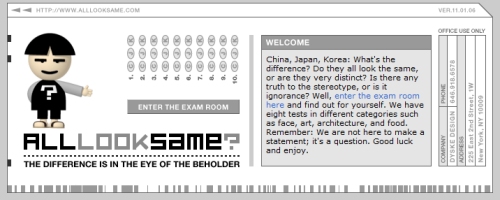

Introduction:
Digital Racial Formations
Chapter 1:
"Ramadan is Almoast Here"
Chapter 2:
Alllooksame
Chapter 3:
The Social Optics of Race
Chapter 4:
Avatars and Visual Culture
Chapter 5:
Measuring Race on the Internet
Epilogue:
Racio-Visual Logic
Conclusions on Digitizing Race
Suematsu [the designer of alllooksame.com] writes that he designed the site "ultimately as a joke” and that he “didn’t mean this site as some sort of political arena.” Despite this, he writes in an essay to the user “Some people felt that this site would promote racism, or that the site itself is racist. Others felt quite the opposite. I was very surprised to receive many emails with encouraging words from Chinese, Korean and Japanese people. In some ways, I was expecting to upset many of these people.” (p. 80) Chapter 2 of Nakamura’s book focuses on the concept of “passing” or of general racial ambiguity. She begins the chapter by relating the story of the Navajo Code Talkers and drawing upon the Turing Test to make comparisons between humans being better at codes than machines and machines convincing humans they are sentient. The bulk of the chapter examines the website alllooksame, a web site that displays Asian faces (and now artwork and other things as well) and asks the user to choose whether the image is of Chinese, Korean, or Japanese origin. While I couldn’t find any easy-access statistical updates between the time of Nakamura’s writing and the present, based on the chapter it would appear from the results of the quizzing at alllooksame the stereotype is true: It is difficult for people to differentiate Asians by facial features. Nakamura utilizes the website as an opportunity to comment on the construction of Asian American and Asian American Studies. Here the chapter is rich with references and a review of literature, but at times it becomes slightly unclear as to whether the focus of Nakamura’s argument is that racial identity cannot be tied to visuals alone (the thread that seems to carry from the Code Talkers to the Turing Test to alllooksame and into the construction of Asian American as a racial designation) or if the focus is on defining what should be an Asian American Studies view—or at least an Asian American Studies-friendly view—of Internet research. Both are important concepts, and the juxtaposition between a website that might be seen by some as hateful and racist and a call for careful consideration of race is powerful. |
